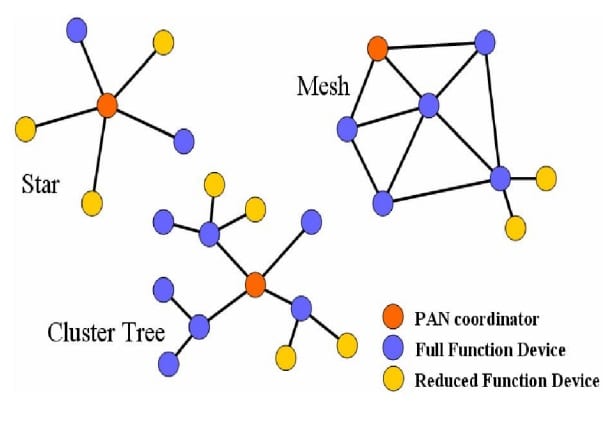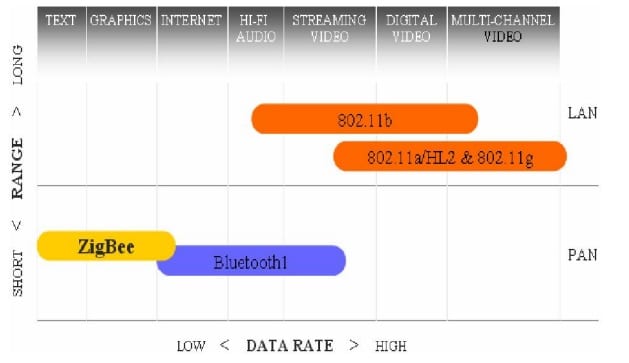ZigBee
Wireless sensor networking is one of the most exciting technology markets today. Over the next five to ten years, wireless sensors will have a
significant impact on almost all major industries as well as our home lives.
ZigBee got its name from the way bees zig and zag while tracking between flowers and relaying information to other bees about where to find resources.
ZigBee is a new global standard for wireless connectivity, focusing on standardizing and enabling interoperability of products. ZigBee is a communications standard that provides a shortrange cost effective networking capability. It has been developed with the emphasis on low-cost battery powered applications.
ZigBee standard
ZigBee has been introduced by IEEE with IEEE 802.15.4 standard and the ZigBee Alliance to provide the first general standard for these applications. The ZigBee alliance includes such companies as Invensys, Honeywell, Mitsubishi Electric, Motorola, and Philips.
ZigBee is built on the robust radio (PHY) and medium attachment control (MAC) communication layers defined by the IEEE 802.15.4 standard.
Above this ZigBee defines mesh, star and cluster tree network topologies with data security features and interoperable application profiles.
There are a multitude of standards (Table 1.) like Bluetooth and WiFi that address mid to high data rates for voice, PC LANs, video, etc.
However, up till now there hasn’t been a wireless network standard that meets the unique needs of sensors and control devices.
Sensors and controls don’t need high bandwidth but they do need low latency and very low energy consumption for long battery lives and for large device arrays.
ZigBee looks rather like Bluetooth but is simpler, has a lower data rate and spends most of its time snoozing. It is now widely recognized that
standards such as Bluetooth and WLAN are not suited for low power applications, which is due to these standards’ high node costs as well as complex and power demanding RF-ICs and protocols.
With Zigbee, the case is different, it is the only standard that specifically addresses the needs of wireless control and monitoring applications.
It has large number of nodes/sensors necessitates wireless solutions, very low system/node costs, need to operate for years on inexpensive batteries; this requires low power RF-ICs and protocols, reliable and secure links between network nodes, easy deployment and no need for high data rates[1].
Table 1. Wireless standard comparisons
GENERAL CHARACTERISTICS of ZigBee
IEEE 802.15.4-2003 standard defines the protocol and interconnection of devices via radio communication in a personal area network (PAN). The standard uses carrier sense multiple access with a collision avoidance medium access mechanism and supports star as well as peer-to-peer topologies. The media access is contention based.
The physical level (PHY) of the 802.15.4 standard specifies three frequency bands, though an implementation need only operate on one of the three.
Fig. 1. PHY Layers
Table 2. General Characteristics
The bands (shown in Table 2.) are: 868 MHz for European applications, 902-928 MHz – for North American applications, 2.400 GHz – for world wide applications. There is a single channel between 868 and 868.6 MHz, 10 channels between 902.0 and 928.0 MHz, and 16 channels between 2.4 and 2.4835 GHz as shown in Figure 1. Several channels in different frequency bands enables the ability to relocate within spectrum. The standard also allows dynamic channel selection, a scan function that steps through a list of supported channels in search of beacon, receiver energy detection, link quality indication, channel switching. Lower frequency provide longer range due to lower propagation losses. Low rate can be translated into better sensitivity and larger coverage area. Higher rate means higher throughput, lower latency or lower duty cycle.
DEVICE TYPES AND NETWORK TOPOLOGIES in ZigBee
The ZigBee network node is designed for, battery powered or high energy savings, searches for available networks, transfers data from its application as necessary, determines whether data is pending, requests data from the network coordinator, can sleep for extended periods.
There are two physical device types for the lowest system cost defined by the IEEE. Full function device (FFD) can function in any topology, is capable of being the network coordinator and can talk to any other device.
Reduced function device (RFD) is limited to star topology, can not become a network coordinator, talks only to a network coordinator has very simple implementation.
An IEEE 802.15.4/ZigBee network requires at least one full function device as a network coordinator, but endpoint devices may be reduced functionality devices to reduce system cost.
The FFD can operate in three modes(Fig. 2.) serving as a personal area network (PAN) coordinator, a coordinator, or a device. An RFD is intended for applications that are extremely simple, such as a light switch or a passive infrared sensor; they do not have the need to send large amounts of data and may only associate with a single FFD at a time. Consequently, the RFD can be implemented using minimal resources and memory capacity.
The IEEE802.15.4 MAC is flexible enough to handle each of these types. Periodic data can be handled using the beaconing system whereby the sensor will wake up for the beacon, check for any messages and then go back to sleep.
Intermittent data can be handled either in a beaconless system or in a disconnected fashion. In a disconnected operation the device will only attach to the network when it needs to communicate saving significant energy.
Low latency applications may choose to the guaranteed time slot (GTS) option. GTS is a method of QoS in that it allows each device a
specific duration of time each Superframe to do whatever it wishes to do.
Mesh networking makes up for the limited power of each individual node by leveraging the ability to relay data through nearby cooperating nodes. This happens transparently and provides redundancy and reliability, assuming the density of nodes is high enough. It’s a case of the value of the network growing at a greater rate than the rate at which you add nodes to it. The overhead of occasional network reconfiguration takes only a few tens of milliseconds.
The ZigBee network coordinator (Fig. 3.) sets up a network, transmits network beacons, manages network nodes , stores network node information, routes messages between paired nodes , typically operates in the receive state. An FFD used as a coordinator needs sufficient memory to hold the network configuration, data, and processing power to self-configure the network in addition to its application task. A router stores and forwards messages to and from devices that can’t directly swap messages. A coordinator would use a lot more power than a simple node at the edge of the network and may require line power or be powered from a device with a substantial power supply.
ZigBee uses direct sequence spread spectrum (DSSS) modulation in mixedmesh, star, and peer to-peer topologies (including cluster-free) to deliver a reliable data service with optional acknowledgments.
The range per node is a nominal 10 m, but popular implementations have a single-hop range of up to 100 m per node line of sight (and farther if relaying through other nodes). ZigBee employs 64 bit IEEE addresses and shorter 16-bit ones for local addressing, which allows thousands of nodes per network.
Zigbee network model
When security of M\AC layer frames is desired, ZigBee uses M\AC layer security to secure M\AC command, beacon, and acknowledgement frames.
Application of ZigBee devices
This technology includes application segments in home control (Fig. 4.): wireless home security, remote thermostats, remote lighting, drape controller, automated meter reading, personal healthcare and advanced tagging, call button for elderly and disabled, universal remote controller to TV and radio, lighting, wireless keyboard, mouse and game pads, wireless smoke, CO detectors, etc.
ZigBee devices can be used for building automation and industrial control and monitoring, container security/tracking, commercial controls, marine wireless and many other.
CONCLUSION ZigBee
ZigBee might be a best option if the following is required: small size, cost sensitivity, low latency, low power, and interoperability. But the biggest reason to choose ZigBee is by far the implementation of the cutting-edge technology. It zigzags its way around the other wireless options.
Although it is inferior to almost all of the others in data rate, it surpasses them in the terms of probability in sophisticated equipment and data control. ZigBee is the best solution for low data rate, short range communications (Fig. 5.).








